Electrical Properties of Li+-Doped Potassium Sodium Niobate Coating Prepared by Supersonic Plasma Spraying
Abstract
:1. Introduction
2. Experimental Procedures
2.1. Materials and Methods
2.2. Characterization
3. Results and Discussions
3.1. Phase Composition of Potassium Sodium Niobate (KNN) and KNLN ((K0.4675Na0.4675Li0.065) NbO3) Powders and Coatings
3.2. Three-Dimensional Morphology of KNN and KNLN Coatings
3.3. Cross-Sectional Morphology of KNN and KNLN Coatings
3.4. Ferroelectric Properties of KNN and KNLN Coatings
3.5. Dielectric Properties and Piezoelectric Properties of KNN and KNLN Coatings
3.6. Energy Spectrum of KNN Coating and X-ray Photoelectron Spectroscopy (XPS) Analysis of Li-Doped KNN Powder and Coating
4. Conclusions
- The prepared KNN and KNLN coatings have compact morphology and small surface roughness, but the KNN coating contains some unmelted particles, and there are micro cracks at the junction of the two coatings and the substrate, which are caused by the mismatch of the thermal expansion coefficient of the ceramic and the substrate. Both coatings are of a single perovskite structure. The pure KNN coating is an orthogonal phase structure, and the doping of Li+ successfully builds a polycrystalline phase boundary in which O–T phases coexist, which has higher dielectric, piezoelectric and ferroelectric properties.
- With the increase of polarization voltage, the pure KNN coating is flatter and fuller, but the leakage current is large. The hysteresis loop of the KNLN coating is relatively slender and easy to polarize, and domain deflection responds faster to an external electric field. The resistance of the domain wall motion to the external electric field is small, therefore, the O–T phase coexistence structure has higher ferroelectric performance.
- The dielectric constant of the KNLN coating is 375, which is much higher than 125 of the pure KNN coating, and the dielectric loss is stable at 0.01, which is lower than the 0.1–0.35 of the pure KNN coating. The d33 of KNN coating and KNLN coating are 8 and 14, respectively. Therefore, the O–T phase coexistence structure has a higher dielectric and piezoelectric properties.
- Due to the high-temperature acceleration process in the supersonic plasma spraying process, the violent volatilization of the alkaline elements Li+, Na+ and K+ results in the existence of oxygen vacancies and part of Nb4+ in the coating, which will seriously affect the electrical properties of the coating.
Author Contributions
Funding
Institutional Review Board Statement
Informed Consent Statement
Data Availability Statement
Conflicts of Interest
References
- Malric, B.; Dallaire, S.; El-Assal, K. Crystal structure of plasma-sprayed PZT thick films. Mater. Lett. 1987, 5, 246–249. [Google Scholar] [CrossRef]
- Thielsch, R.; Haessler, W.; Brueckner, W. Electrical properties and mechanical stress of thick plasma-sprayed Pb (Zr0. 58Ti0. 42) O3 coatings. Phys. Status Solidi (A) 1996, 156, 199–207. [Google Scholar] [CrossRef]
- Sherrit, S.; Savin, C.R.; Wiederick, H.D.; Mukherjee, B.K.; Prasad, S.E. Plasma-Sprayed lead zirconate titanate-glass composites. J. Am. Ceram. Soc. 1994, 77, 1973–1975. [Google Scholar] [CrossRef]
- Li, G.; Gu, L.; Wang, H.; Xing, Z.; Zhu, L. Microstructures and dielectric properties of PZT coatings prepared by supersonic plasma spraying. J. Therm. Spray Technol. 2014, 23, 525–529. [Google Scholar] [CrossRef]
- Liu, Z.; Xing, Z.; Wang, H.; Xue, Z.; Chen, S.; Jin, G.; Cui, X. Effect of ZnO on the microstructure and dielectric properties of BaTiO3 ceramic coatings prepared by plasma spraying. J. Alloys Compd. 2017, 727, 696–705. [Google Scholar] [CrossRef]
- Xing, Z.; Wang, H.; Zhu, L.; Zhou, X.; Huang, Y. Properties of the BaTiO3 coating prepared by supersonic plasma spraying. J. Alloys Compd. 2014, 582, 246–252. [Google Scholar] [CrossRef]
- Sen, C.; Alkan, B.; Akin, I.; Yucel, O.; Sahin, F.C.; Goller, G. Microstructure and ferroelectric properties of spark plasma sintered Li substituted K0. 5Na0. 5NbO3 ceramics. J. Ceram. Soc. Jpn. 2011, 119, 355–361. [Google Scholar] [CrossRef] [Green Version]
- Chin Goh, P.; Yao, K.; Chen, Z. Lithium diffusion in (Li, K, Na) NbO3 piezoeletric thin films and the resulting approach for enhanced performance properties. Appl. Phys. Lett. 2011, 99, 092902. [Google Scholar] [CrossRef]
- Fu, F.; Shen, B.; Zhai, J.; Xu, Z.; Yao, X. Electrical properties of Li doped sodium potassium niobate thick films prepared by a tape casting process. J. Alloys Compd. 2011, 509, 7130–7133. [Google Scholar] [CrossRef]
- Shen, Z.Y.; Li, Y.M.; Jiang, L.; Li, R.R.; Wang, Z.M.; Hong, Y.; Liao, R.H. Phase transition and electrical properties of LiNbO3-modified K0.49Na0.51NbO3 lead-free piezoceramics. J. Mater. Sci. Mater. Electron. 2011, 22, 1071–1075. [Google Scholar] [CrossRef]
- Chen, S.; Tan CK, I.; Yao, K. Potassium–Sodium Niobate-Based Lead-Free Piezoelectric Ceramic Coatings by Thermal Spray Process. J. Am. Ceram. Soc. 2016, 99, 3293–3299. [Google Scholar] [CrossRef]
- Guo, K.; Chen, S.; Tan, C.K.I.; Sharifzadeh Mirshekarloo, M.; Yao, K.; Tay, F.E.H. Bismuth sodium titanate lead-free piezoelectric coatings by thermal spray process. J. Am. Ceram. Soc. 2017, 100, 3385–3392. [Google Scholar] [CrossRef]
- Guo, K.; Mirshekarloo, M.S.; Lin, M.; Yao, K.; Chen, S.; Tay, F.E.H. Microstructure and piezoelectric properties of thermal sprayed Bi0. 5 (Na0. 70K0. 20Li0. 10) 0.5 TiO3 ceramic coatings. Ceram. Int. 2019, 45, 3570–3573. [Google Scholar] [CrossRef]
- Wang, L.; Yao, K.; Ren, W. Piezoelectric K0.5Na0.5NbO3 thick films derived from polyvinylpyrrolidone-modified chemical solution deposition. Appl. Phys. Lett. 2008, 93, 092903. [Google Scholar] [CrossRef]
- Rubio-Marcos, F.; Ochoa, P.; Fernandez, J.F. Sintering and properties of lead-free (K,Na,Li)(Nb,Ta,Sb)O 3 ceramics. J. Eur. Ceram. Soc. 2007, 27, 4125–4129. [Google Scholar] [CrossRef]
- Higashide, K.; Kakimoto, K.; Ohsato, H. Temperature dependence on the piezoelectric property of (1− x)(Na0. 5K0. 5) NbO3–xLiNbO3 ceramics. J. Eur. Ceram. Soc. 2007, 27, 4107–4110. [Google Scholar] [CrossRef]
- Rubio-Marcos, F.; Marchet, P.; Romero, J.J.; Fernández, J.F. Structural, microstructural and electrical properties evolution of (K, Na, Li)(Nb, Ta, Sb) O3 lead-free piezoceramics through NiO doping. J. Eur. Ceram. Soc. 2011, 31, 2309–2317. [Google Scholar] [CrossRef]
- Baig, M.N.; Khalid, F.A. Deposition and characterization of plasma sprayed Ni-5A1/magnesia stabilized zirconia based functionally graded thermal barrier coating. In Proceedings of the IOP Conference Series: Materials Science and Engineering, Islamabad, Pakistan, 23–27 September 2013; Volume 60, p. 012053. [Google Scholar]
- Song, D.; Wang, R.; Liu, W.; He, X. Microstructure and mechanical properties of PbSn alloys deposited on carbon fiber reinforced epoxy composites. J. Alloys Compd. 2010, 505, 348–351. [Google Scholar] [CrossRef]
- Zhen-yu, Z.; Qiu-yang, Z.; Cong, D.; Ju-yu, Y.; Guang-jian, P.; Zhong-yu, P. Research on the promotion mechanism of surface burnishing process by two-dimensional ultrasonic vibration. J. Mater. Res. Technol. 2021, 13, 1068–1082. [Google Scholar] [CrossRef]
- Izyumskaya, N.; Alivov, Y.I.; Cho, S.J.; Morkoç, H.; Lee, H.; Kang, Y.S. Processing, structure, properties, and applications of PZT thin films. Crit. Rev. Solid State Mater. Sci. 2007, 32, 111–202. [Google Scholar] [CrossRef]
- Hsueh, C.H.; Luttrell, C.R.; Cui, T. Thermal stress analyses of multilayered films on substrates and cantilever beams for micro sensors and actuators. J. Micromech. Microeng. 2006, 16, 2509. [Google Scholar] [CrossRef]
- Zhou, Z.; Zheng, Q.; Ding, C.; Yan, J.; Piao, Z. Effect of surface burnishing process with different strain paths on the copper microstructure. J. Manuf. Processes 2021, 71, 653–668. [Google Scholar] [CrossRef]
- Safari, A.; Abazari, M. Lead-free piezoelectric ceramics and thin films. IEEE Trans. Ultrason. Ferroelectr. Freq. Control 2010, 57, 2165–2176. [Google Scholar] [CrossRef]
- Nguyen, M.D.; Dekkers, M.; Houwman, E.P.; Vu, H.T.; Vu, H.N.; Rijnders, G. Lead-free (K0. 5Na0. 5) NbO3 thin films by pulsed laser deposition driving MEMS-based piezoelectric cantilevers. Mater. Lett. 2016, 164, 413–416. [Google Scholar] [CrossRef]
- Zhu, W.; Akkopru-Akgun, B.; Trolier-McKinstry, S. Highly accelerated lifetime testing of potassium sodium niobate thin films. Appl. Phys. Lett. 2017, 111, 212903. [Google Scholar] [CrossRef]
- Egerton, L.; Dillon, D.M. Piezoelectric and dielectric properties of ceramics in the system potassium—Sodium niobate. J. Am. Ceram. Soc. 1959, 42, 438–442. [Google Scholar] [CrossRef]
- Winotai, P.; Udomkan, N.; Meejoo, S. Piezoelectric properties of Fe2O3-doped (1− x) BiScO3–xPbTiO3 ceramics. Sens. Actuators A Phys. 2005, 122, 257–263. [Google Scholar] [CrossRef]
- Choi, S.W.; Shrout, T.R.; Jang, S.J.; Bhalla, A.S. Morphotropic phase boundary in Pb (Mg13Nb23) O3-PbTiO3 system. Mater. Lett. 1989, 8, 253–255. [Google Scholar] [CrossRef]
- Moulder, J.F. Handbook of X-ray photoelectron spectroscopy. Phys. Electron. 1995, 88, 230–232. [Google Scholar]
- Atuchin, V.V.; Kalabin, I.E.; Kesler, V.G.; Pervukhina, N.V. Nb 3d and O 1s core levels and chemical bonding in niobates. J. Electron Spectrosc. Relat. Phenom. 2005, 142, 129–134. [Google Scholar] [CrossRef]
- Popovič, A.; Bencze, L.; Koruza, J.; Malič, B. Vapour pressure and mixing thermodynamic properties of the KNbO 3–NaNbO 3 system. RSC Adv. 2015, 5, 76249–76256. [Google Scholar] [CrossRef]
- Hreščak, J.; Dražić, G.; Deluca, M.; Arčon, I.; Kodre, A.; Dapiaggi, M.; Rojac, T.; Malič, B.; Bencan, A. Donor doping of K0. 5Na0. 5NbO3 ceramics with strontium and its implications to grain size, phase composition and crystal structure. J. Eur. Ceram. Soc. 2017, 37, 2073–2082. [Google Scholar] [CrossRef] [Green Version]
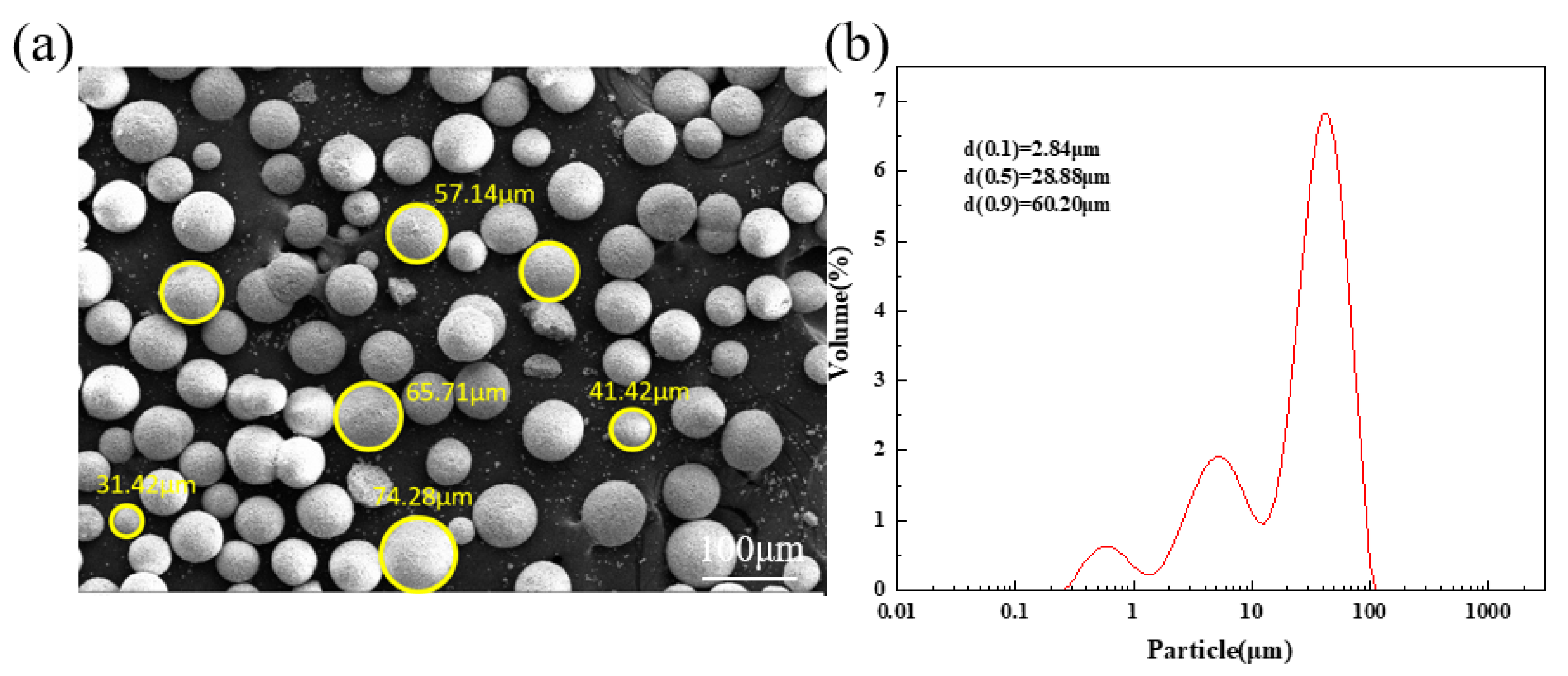
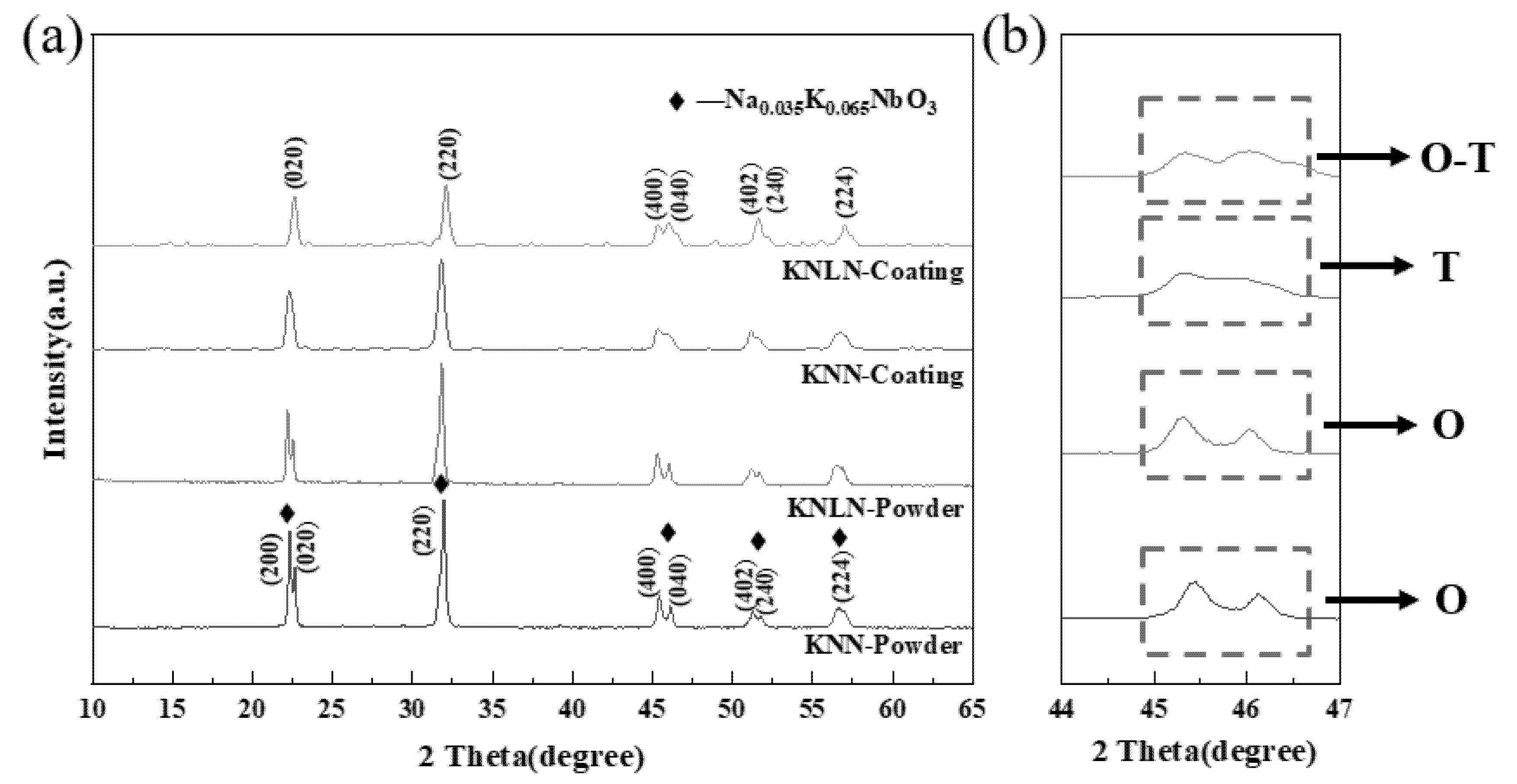


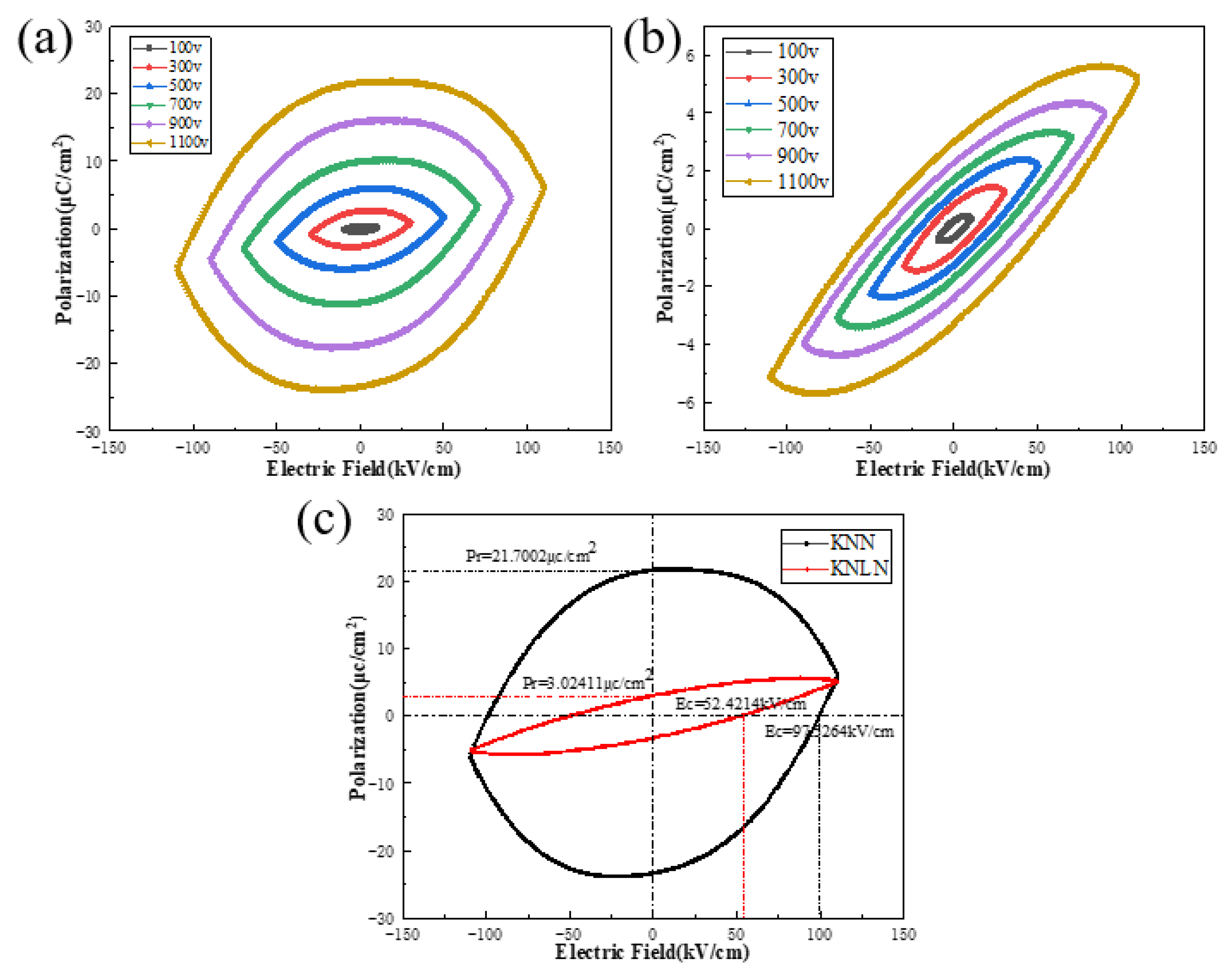
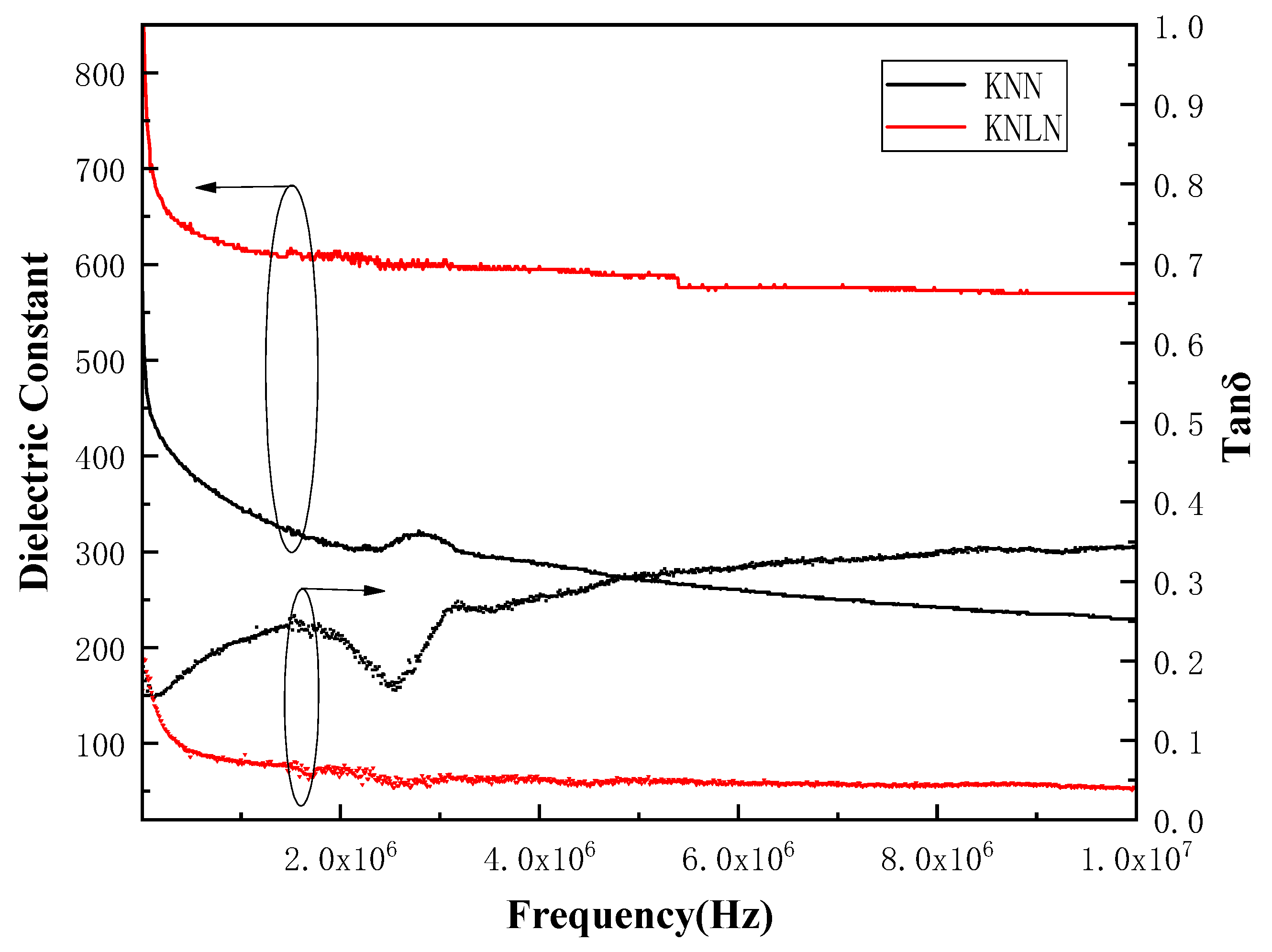
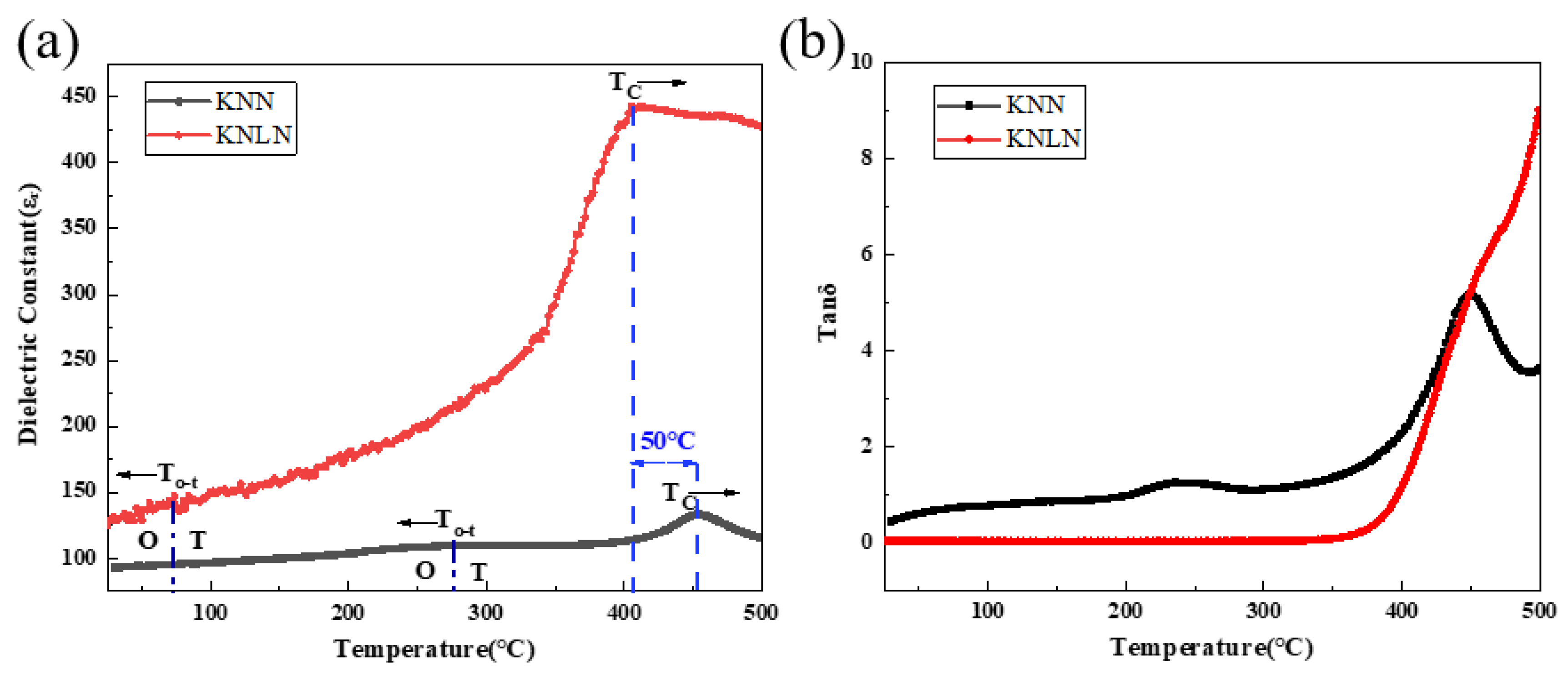
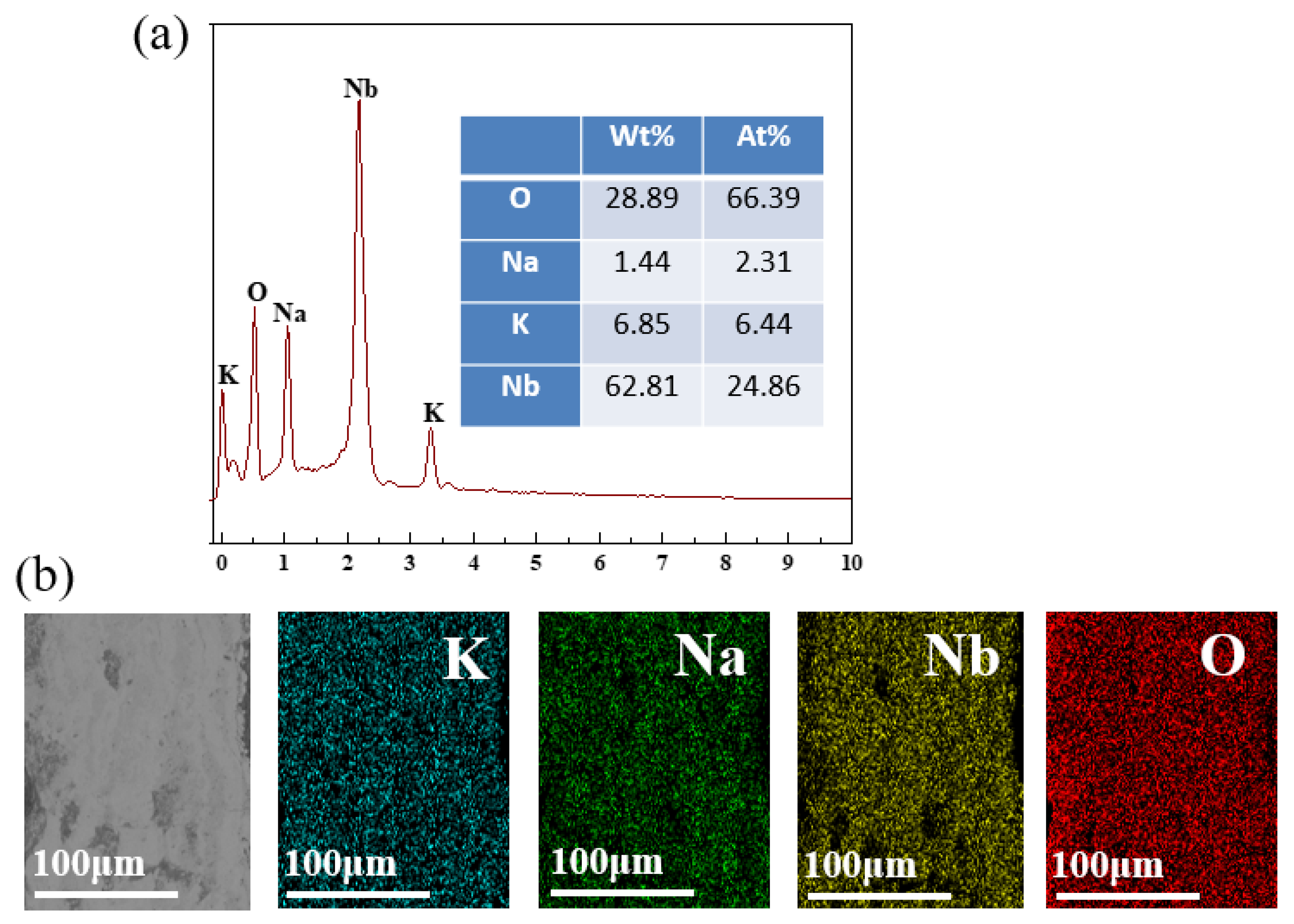
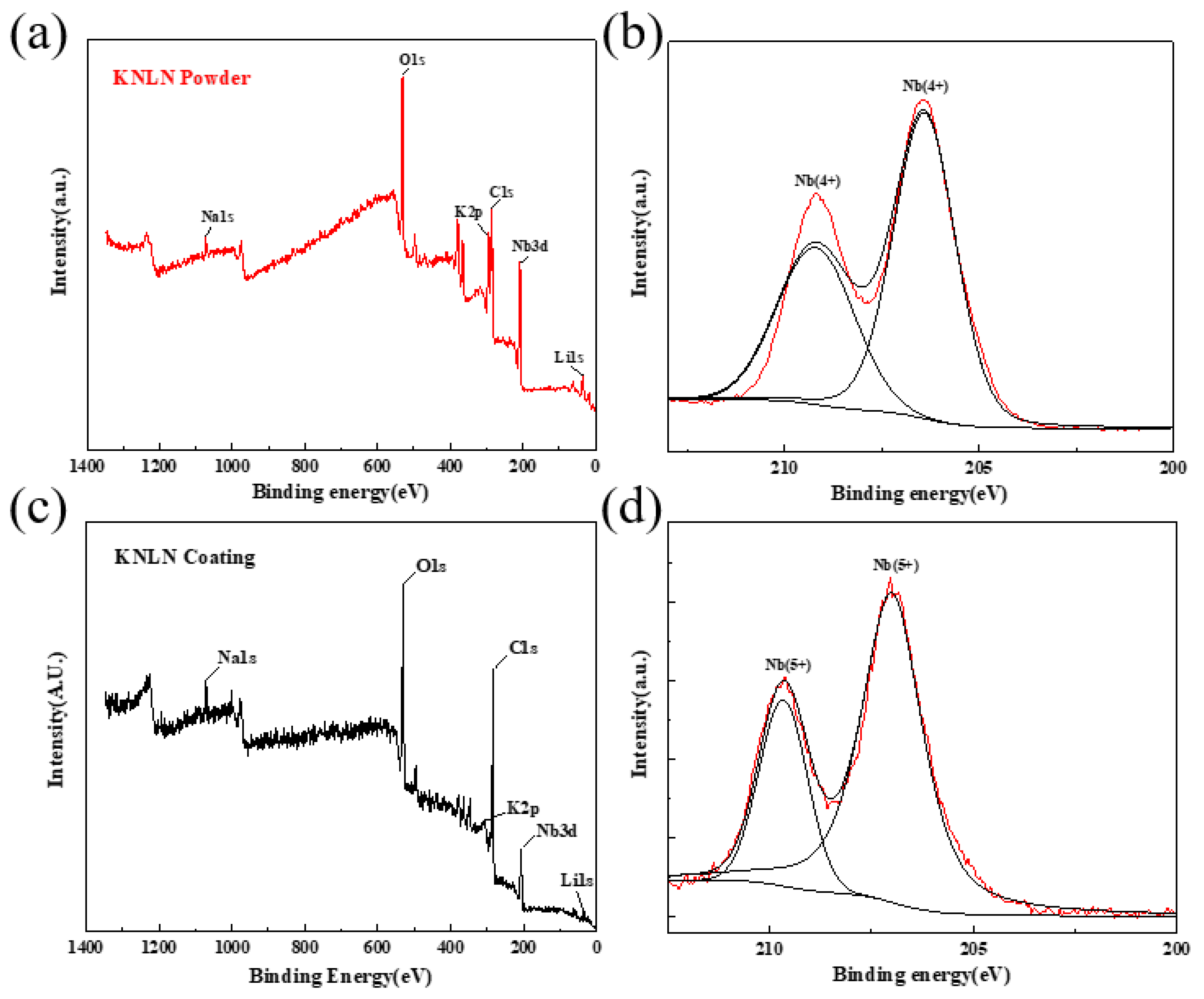
| Parameter (Unit) | Value |
|---|---|
| Spraying current (A | 420 |
| Spraying voltage (V) | 100 |
| Spraying distance (mm) | 100 |
| Primary gas Ar (m3h−1) | 7.2 |
| Secondary gas H2 (m3h−1) | 0.48 |
| Powder feeding rate (g min−1) | 20 |
| Material | Coefficient of Thermal Expansion (10−6/°C) | Young’s Modulus (GPa) |
|---|---|---|
| KNN | 8 | 66 |
| Ag/Pd | 15 | 145 |
| YSZ | 10 | 38 |
| NiCrAlY | 15 | 137 |
| Steel | 17 | 200 |
| Material | d33/pC/N | To-t/°C | Tc/°C |
|---|---|---|---|
| KNN | 8 | 280 | 455 |
| KNLN | 15 | 75 | 405 |
Publisher’s Note: MDPI stays neutral with regard to jurisdictional claims in published maps and institutional affiliations. |
© 2022 by the authors. Licensee MDPI, Basel, Switzerland. This article is an open access article distributed under the terms and conditions of the Creative Commons Attribution (CC BY) license (https://creativecommons.org/licenses/by/4.0/).
Share and Cite
Song, Y.; Huang, Y.; Guo, W.; Zhou, X.; Xing, Z.; He, D.; Lv, Z. Electrical Properties of Li+-Doped Potassium Sodium Niobate Coating Prepared by Supersonic Plasma Spraying. Actuators 2022, 11, 39. https://doi.org/10.3390/act11020039
Song Y, Huang Y, Guo W, Zhou X, Xing Z, He D, Lv Z. Electrical Properties of Li+-Doped Potassium Sodium Niobate Coating Prepared by Supersonic Plasma Spraying. Actuators. 2022; 11(2):39. https://doi.org/10.3390/act11020039
Chicago/Turabian StyleSong, Yaya, Yanfei Huang, Weiling Guo, Xinyuan Zhou, Zhiguo Xing, Dongyu He, and Zhenlin Lv. 2022. "Electrical Properties of Li+-Doped Potassium Sodium Niobate Coating Prepared by Supersonic Plasma Spraying" Actuators 11, no. 2: 39. https://doi.org/10.3390/act11020039
APA StyleSong, Y., Huang, Y., Guo, W., Zhou, X., Xing, Z., He, D., & Lv, Z. (2022). Electrical Properties of Li+-Doped Potassium Sodium Niobate Coating Prepared by Supersonic Plasma Spraying. Actuators, 11(2), 39. https://doi.org/10.3390/act11020039







